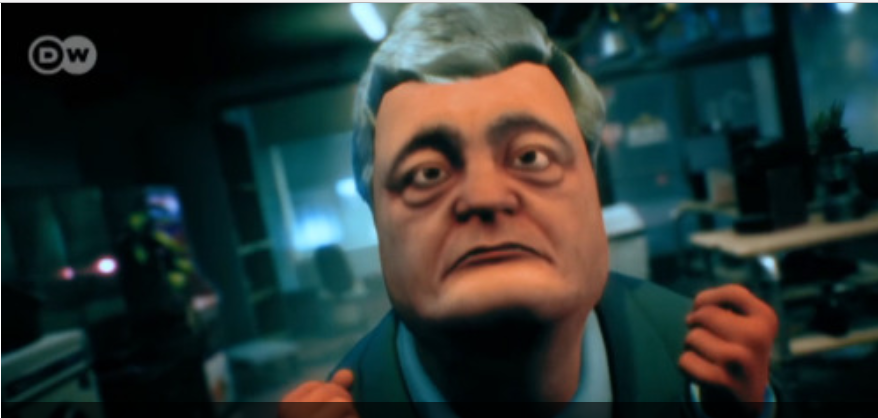
This is not the first time that Deutsche Welle’s coverage of recent events, most specifically Russia’s invasion and annexation of Crimea, have caused bemusement, KHPG reports.
The new weekly satirical program bears a similarity to the original Russian Kukly satire and also uses characters from Soviet cartoons. It is produced for the Russian DW page, with the very negative image of Ukraine’s President in two clips speaking ‘Surzhik’ (Ukrainian which has been heavily influenced by Russian] to elicit further laughs from the target audience.
The scene with Poroshenko in a shop asking for lethal weapons from Donald Trump was used as a trailer for the first episode. Poroshenko is seen begging ‘Trump’ for lethal weapons [in fact, something like ‘mind-blowing’ weapons] as his country has been invaded by Martians. This Trump figure asks what kind of Martians, where they’ve come from”, and is told that they’re from Russia, where else? They’re little green men, very green, and damn it, polite”. The rest of the clip is of questionable, but predictable, humor, with Poroshenko wreaking havoc by trying out the weapons he’s shown.
For Russians watching the program, both Poroshenko and his bewailing an “invasion by Martians” seem comical. The fact that these ‘Martians’ are then “of course from Russia, because they’re ‘green’, would doubtless be music to many Russians’ ears. It is hard to take either Poroshenko or his lamentations seriously. What could be better as a way of enabling Russian viewers to avoid confronting the one uncomfortable truth that strips DW’s clip of any humor, the human rights watchdog asks.
Read alsoStoltenberg says NATO to revamp command structure amid tensions with Russia – mediaUkraine was invaded in 2014, not by Martians, but by Russian soldiers without insignia who seized control in Crimea.
The invasion of eastern Ukraine was even less open, and to this day Russia is denying its military engagement.
That denial is regularly dismissed by military analysts, NATO, OSCE, and western governments. Dr Igor Sutyagin, in a briefing paper for the Royal United Services Institute [RUSI] on Russian forces in Ukraine, concluded that the “first phase of large-scale incursions by regular Russian troops commenced on 11 August 2014 and has involved a substantial array of forces”. He put the figure for direct Russian military personnel as up to “10,000 at the peak of direct Russian involvement in the middle of December 2014.”
Read alsoEscalation in Donbas: 17 attacks on Ukraine troops, 2 KIA's, 3 WIA's in last daySutyagin saw this as the second act of direct military aggression by the Russian military. The first had come from mid-July 2014, as Russia understood that Ukraine was about to defeat the Russian-backed and armed militants.
It was after the downing of Malaysian airliner MH17 with the loss of 298 lives that the West first introduced real sanctions against Russia. It is worth recalling the findings of the official Joint Investigation Team, published on 28 September 2016 and available for study on a Dutch government website.
The JIT “concludes that flight MH17 was shot down on 17 July 2014 by a missile of the 9M38 series, launched by a BUK-TELAR, from farmland in the vicinity of Pervomaiskiy (or: Pervomaiskyi). At that time, the area was controlled by pro-Russian fighters. Furthermore, the investigation also shows that the BUK-TELAR was brought in from the territory of the Russian Federation and subsequently, after having shot down flight MH-17, was taken back to the Russian Federation.”
Details about Viktor Ageyev, the latest Russian contract soldier to be captured while fighting in Russia’s undeclared war can be found here.
See also: Russia uses money and threat of prosecution to hide Russian soldiers’ deaths in Ukraine and Russia’s weapons of Ukraine’s destruction were not "found in Donbas mines"
Over 10 thousand Ukrainians have been killed in the conflict, and at least 1.63 million displaced (as of February 2017). Russia’s occupation of Crimea has resulted in a grave deterioration in human rights, and the aggression in general against Ukraine has resulted in over 60 Ukrainians, including renowned filmmaker Oleg Sentsov, illegally imprisoned in Russia or occupied Crimea.
The list of reasons why humor is strictly limited is much longer.
Read alsoJIT countries confirm support for Dutch prosecution of MH17 suspectsAs mentioned, this is not the first time that Deutsche Welle’s coverage has aroused concern. In the summer of 2016, Juri Rescheto, head of DW’s Moscow office took part in a propaganda visit to occupied Crimea, with his presence and comments, actual or alleged, used to enable the Kremlin-funded RT [the former Russia Today] and other such media to come up with pieces such as ‘It is now a fact’: Western journalists visit Crimea, say it’s now ‘Russian territory’.
Then on August 19, DW produced another report, this time with a map of Ukraine and Russia. Although, if you scrutinized it, you understood that Crimea was, in fact, striped yellow, like Russia, and orange, like Ukraine, this required close attention and was not the impression TV viewers would have received. It looked yellow. In fact, it still does, although a DW official promised in a letter to the author of these words that the maps would be made clearer. Whether, in fact, stripes are appropriate can be questioned. Crimea is not ‘disputed’ territory: it is Ukrainian territory illegally occupied by Russia, with this unequivocally spelled out by the UN General Assembly and all democratic countries.
Deutsche Welle has reacted to criticism by pointing out that they have prepared material about human rights abuses, etc. This is true, at least of the Ukrainian Service, and to be welcomed. The problem is that any given viewer may only watch one particular program. If they know next to nothing about Crimea, or the events of 2014, they can easily be misled by that one news item or feature. This makes it imperative that much greater care is taken, and sensitivity shown, especially by taxpayer-funded public broadcasters like Deutsche Welle.

